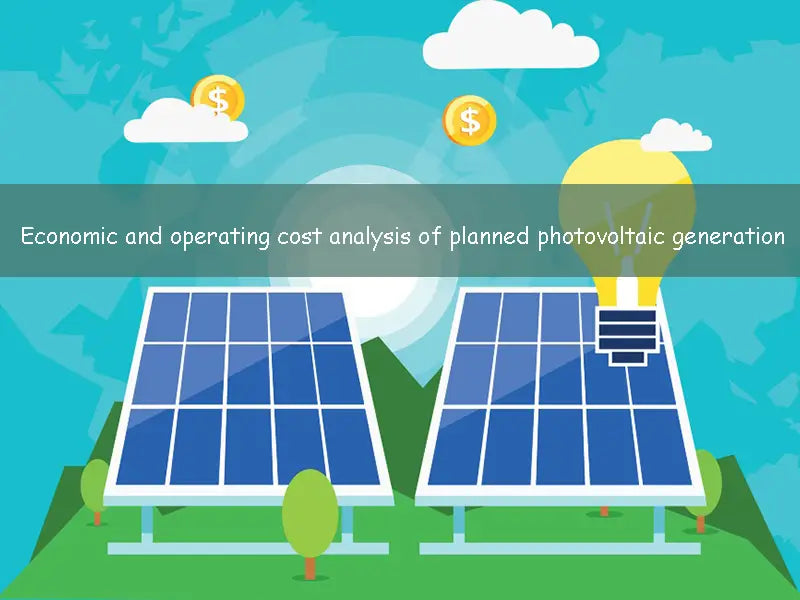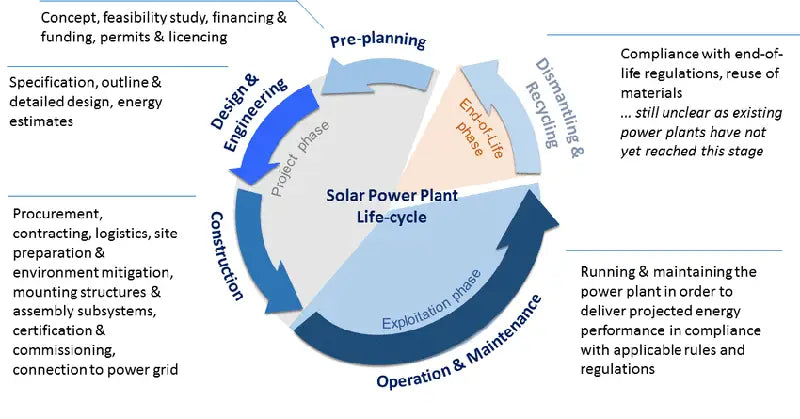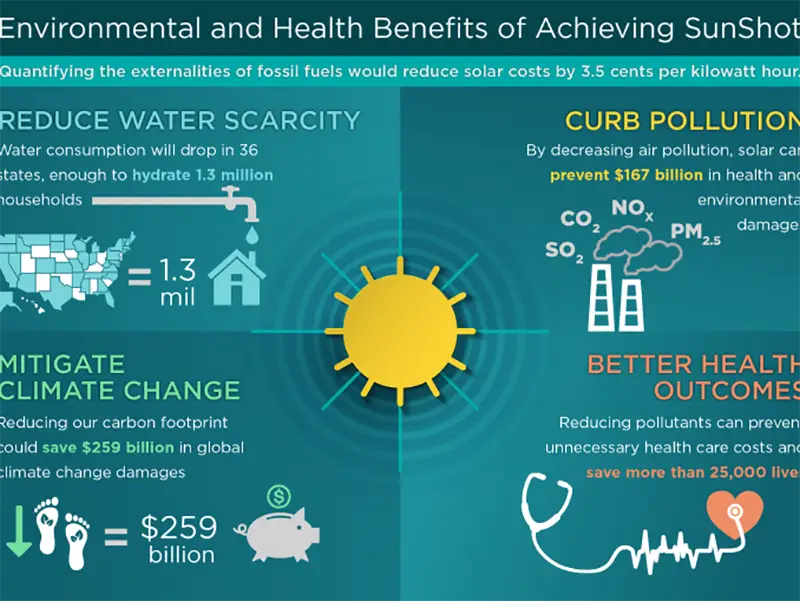
Main content:
- Analysis of investment income of photovoltaic power station
- Cost of photovoltaic power station
- Photovoltaic generation
- Environmental Benefit Analysis of photovoltaic generation Energy Saving and Emission Reduction
- Phased energy recovery of solar photovoltaic generation systems
- Large-scale photovoltaic development requires subsidies
- Measures to improve the economic benefits of photovoltaic generation
The economic benefits of photovoltaic generation cannot be analyzed according to the investment income of conventional power supply construction. The economic benefits of photovoltaic generation need to be comprehensively considered from the perspective of photovoltaic power station construction, grid connection and power system operation. benefit.
1. Analysis of investment income of photovoltaic power station
1.1 Cost of photovoltaic power station
In 2008, the cost of grid-connected photovoltaic generation system was about 40,000 yuan per kilowatt. In 2009, due to the impact of the financial crisis, the cost of grid-connected photovoltaic generation system was greatly reduced, and the minimum price of photovoltaic generation system was reduced to about 20,000 yuan per kilowatt. But in general, the system cost of domestic optoelectronic projects varies greatly, and the unit cost per kilowatt-hour ranges from 20,000 to 40,000 yuan. The investment of photovoltaic modules accounts for about 54.5% of the investment cost of grid-connected photovoltaic generation systems, which has a great impact on the cost of the entire photovoltaic generation system.
1.2 Photovoltaic generation
The theoretical annual power generation of a photovoltaic power station is the product of the installed capacity of the photovoltaic power station and the annual effective utilization hours of solar energy on the surface of the photovoltaic module. The efficiency of the solar photovoltaic generation system should be considered for the on-grid power. The efficiency of the solar photovoltaic generation system includes: solar cell aging efficiency, AC and DC low voltage System loss and other equipment aging efficiency, inverter efficiency, transformer and grid loss efficiency. Due to the influence of aging and other factors, the power generation efficiency of the solar photovoltaic system decreases year by year, and the battery aging coefficient is calculated by 0.90% year by year; the loss of the solar battery array combination, dust shielding, line loss and inverter, transformer, etc. The aging of electrical equipment reduces the system efficiency. The comprehensive efficiency of large-scale ground photovoltaic power station loss and aging is taken as 80%, and the comprehensive efficiency of roof photovoltaic generation loss and aging is taken as 81.5%.
In 2010, the installed capacity of photovoltaics in Qinghai Province was 200MW. In 2015, the planned installed capacity of photovoltaics in Qinghai Province was 010MW. According to the annual equivalent power generation utilization hours of 1500h, the photovoltaic on-grid electricity in 2010 was 240GW·h.
In 2015, it was 1210GW·h.
1.3 Environmental Benefit Analysis of photovoltaic generation Energy Saving and Emission Reduction
Coal consumption and low carbon dioxide emissions play an important role in improving the ecological environment and alleviating the greenhouse effect, with social benefits of energy saving and emission reduction.
In 2009, the national average coal consumption for thermal power generation was 339g/kW. According to the forecast results of photovoltaic generation, the photovoltaic power station planned in 2015 can reduce the annual consumption of standard coal by 411,100 tons. According to relevant information, the current average benefit of photovoltaic power in China is 0.081 yuan/kW·h, and the planned environmental benefit of photovoltaic power plants in 2015 is 98.17 million yuan/year.
1.4 Phased energy recovery of solar photovoltaic generation systems

The solar photovoltaic generation system consumes a certain amount of energy in the production process, especially the three processes of industrial silicon purification, high-purity multi-product silicon production, and monocrystalline silicon ingot/polycrystalline silicon ingot production. High energy consumption. When evaluating the impact of photovoltaic generation on the environment, the part of the energy consumed by the solar photovoltaic generation system in the manufacturing and installation and operation engineering must be considered. The energy payback period of a solar photovoltaic generation system refers to the ratio of the total energy consumed in the whole life cycle to the annual energy output of the solar photovoltaic generation system during operation, in units of years, namely: energy payback period (year) = solar photovoltaic generation Consumption over the life of the system/annual energy output of the solar PV system.
The energy payback period of a solar photovoltaic generation system depends on two aspects of data: one is the energy consumed in the production, transportation, installation and operation of solar photovoltaic generation, which mainly depends on the technical level and operation management ability of production and manufacturing: the second is The amount of electricity generated by the solar photovoltaic generation system depends on the configuration of the photovoltaic cell system and the storage battery system, the installation location and method of the system, the local solar energy resources and the level of operation and maintenance.
(1) Energy consumption during the whole life cycle of the solar photovoltaic generation system. To calculate the energy consumption in the whole life cycle of the solar photovoltaic system, the system boundary of the solar photovoltaic system should be defined first. Theoretically speaking, the system boundary of the whole life cycle study should include the manufacturing, transportation, installation, operation and equipment recycling of the solar photovoltaic generation system. Most studies regard the energy consumption in the manufacturing process of solar photovoltaic production system as the energy consumption in the whole life cycle of solar photovoltaic system.
(2) Distribution of energy consumption in manufacturing. In terms of the energy consumed in the production process of grid-connected solar photovoltaic systems, the single-product silicon solar cell system has the highest energy consumption, reaching 3308kWh/kWp, which is 131% of that of the polycrystalline silicon solar cell system; the thin-film solar cell system has the lowest energy consumption, which is 1995kWh/kWp, 21% lower than polycrystalline silicon solar cell system.
From the perspective of all aspects of battery production, high-purity polysilicon materials, silicon ingots and silicon wafers consume the most energy. In the production of monocrystalline silicon cell systems, the energy consumed by these three processes accounts for 80% of the total energy consumption; in the production of multi-product silicon cell components, the energy consumed by these three processes also accounts for 72.5% of the total energy consumption.
Among the total energy consumption of cells, the energy consumption of producing raw materials high-purity polysilicon and SC accounts for a large proportion, accounting for 80% of the total energy consumption. High-purity polysilicon accounts for 62% of the total energy consumption, and SiC accounts for 18% of the total energy consumption. Energy consumption is only 12%.

(3) The calculation result of the energy payback period. There are two types of literature on the energy payback period of solar photovoltaic systems. One is the research on environmental impact assessment of solar photovoltaic systems. By studying the development status and basic data of the industry, environmental impact assessment is carried out. Energy payback period is an important indicator of environmental impact assessment. One is the special energy payback period research, which uses the industrial basic data of the existing literature to carry out research and analysis on the energy payback period of many cities and regions.
At present, the energy recovery period of the solar grid-connected photovoltaic generation system is 1.5 years to 6.9 years, which is far less than the life period of the solar photovoltaic system (30 years). With the improvement of the technical level and the development of the industry, the energy payback period of the monocrystalline silicon and polycrystalline silicon solar photovoltaic systems may be reduced to less than one year in the future.
According to a study by the International Energy Agency on 41 cities in 26 OECD (Organization for Economic Cooperation and Development) countries, the energy payback period of a polysilicon solar photovoltaic system installed with the best inclination is 1.6 to 3.3 years. The shortest is Perth, Australia, and the most The longest is Edinburgh, UK; the energy payback period of the solar photovoltaic system vertically installed on the façade is 2.7 to 4.7 years, the shortest is Perth, Australia, and the longest is Brossel, Belgium.
Research shows that the energy recovery period of polycrystalline silicon solar photovoltaic systems installed at the best inclination angle in China is 1.57 years to 3.76 years, the shortest is Lhasa, the longest is Chongqing and Chengdu; the solar photovoltaic system installed vertically on the facade wall The energy recovery period is 2.5 years to 6.92 years, the shortest is Lhasa, and the longest is Chongqing.

(4) On-grid electricity price
①The impact of system cost on on-grid electricity price. Assume that the project capital return is 8%; the loan ratio is 80%, the loan period is 20 years, the loan interest rate is 6%, and the equal principal and interest are paid; equipment depreciation and annual operating costs are respectively 5% and 0.2% of the fixed asset investment Considered; the effective utilization hours of annual power generation are 1500h; the land price is not considered
②The influence of solar resource conditions on the on-grid electricity price. The feed-in tariff decreases with the increase in the number of effective utilization hours per year.
③ Relevant national policies. Since 2008, my country's policies on photovoltaic generation have attracted worldwide attention, and policies have been introduced in terms of electricity price subsidies and installation subsidies.
Installation allowance. In March 2009, the Ministry of Finance and the Ministry of Housing and Urban-Rural Development issued the Interim Measures for the Administration of Financial Subsidy Funds for Solar Photovoltaic Building Applications, which proposed to support photovoltaic building application systems and provide an investment subsidy of 20 yuan/Wr. On July 16, 2009, the Ministry of Finance, the Ministry of Science and Technology and the National Energy Administration jointly issued the "Notice on the Implementation of the Golden Sun Demonstration Project". It is planned to support photovoltaic generation demonstration projects of no less than 500MW in the form of financial subsidies within 2 to 3 years. . In principle, grid-connected photovoltaic generation projects will be subsidized by 50%; independent photovoltaic generation systems in remote areas without electricity will be subsidized by 70%.
Electricity subsidy. In August 2008, the National Development and Reform Commission approved the price of 4 yuan per kilowatt-hour for the rooftop solar photovoltaic system in Qianwei Village on Chongming Island in Shanghai and the demonstration power station in the Erdos desert in Inner Mongolia. On June 23, 2009, my country's first photovoltaic generation concession project, the 10MW photovoltaic grid-connected power generation project in Dunhuang, Gansu, was determined to be 1.0928 yuan.
④The development trend of electricity price. The "Preliminary Exploration of China's Photovoltaic Development Route" planned and drafted by SEMI China Photovoltaic Advisory Committee analyzed the technology and cost of solar photovoltaic generation. The cost of photovoltaic generation in China was 1 yuan per kilowatt-hour in 2012. Based on the above analysis, the on-grid price of photovoltaic generation should be in 2020. In the past, in areas rich in solar energy resources? It has the competitive strength with conventional energy power generation prices.

2. Large-scale photovoltaic development requires subsidies
In 2010, the installed capacity of photovoltaics in Qinghai Province was 200MW. In 2015, the original plan was 3200MW. Calculated according to the annual equivalent power generation utilization hours of 1500h, the photovoltaic on-grid electricity was 300GW·h in 2010 and 4800GW·h in 2015.
In 2010, Qinghai photovoltaic on-grid electricity price was implemented according to the current on-grid electricity price of Dunhuang concession projects, namely 1.09 yuan/kW·h, the benchmark on-grid electricity price for desulfurization thermal power was 0.279 yuan/kW·h, and photovoltaic generation required subsidies of 243 million yuan.
In addition, the conventional energy has not been calculated, especially the increase in the electricity price of thermal power. Large-scale photovoltaic generation access system requires the construction of corresponding supporting projects in the power grid, and additional electricity fees need to be increased, which will also lead to an increase in electricity prices.
3. Measures to improve the economic benefits of photovoltaic generation

The grid connection of large-scale photovoltaic generation requires corresponding adjustments to the dispatching operation mode of the power system to ensure the safe and economical operation of the entire system. To improve the economic benefits of photovoltaic generation, on the one hand, it is necessary to make full use of the electricity generated by photovoltaic generation without restricting the grid of photovoltaic generation; Due to the anti-regulation characteristics of intermittent power supply, the difficulty of peak regulation of power grid balance is increased, thereby increasing the difficulty of dispatching and bringing hidden dangers to the safe operation of the power grid; under the existing power system dispatching operation mode, in order to ensure the system Safe and stable operation, if necessary, the system has to limit the output of intermittent power supply, to give full play to the role of photovoltaic generation, improve the economic benefits of photovoltaic generation and the entire system, the necessary solution is to predict photovoltaic power and optimize grid scheduling, Minimize system backup costs.
The power grid company should develop a photovoltaic power prediction system suitable for the province according to the characteristics of the province's power grid and solar energy resources, and gradually establish a photovoltaic dispatching support system, develop photovoltaic power station implementation and operation, control information management system and network-related parameter database, etc. The dispatching operation information can be close to or reach the same level of conventional power plants; photovoltaic generation has remote control ability, so that when the system operation is difficult, photovoltaic generation participates in system dispatching.
Read more: What are the requirements for grid-connected photovoltaic power generation?